Computational Fluid Dynamics Modeling of Ventilation and Hen Environment in Cage-Free Egg Facility
Simple Summary
Abstract
1. Introduction
2. Materials and Methods
2.1. Development of the CFD Model
2.1.1. The Study Poultry House
2.1.2. Two- and Three-Dimensional Computational Domains
2.1.3. Modeling the Birds
2.2. Boundary Conditions
- Wall: The ground, ceiling, roof, slatted floor, nest boxes, litter area, inlet baffles, sidewalls, animal surfaces, and the top surface of the computational domain were defined as wall boundary conditions. Note that all “walls” were defined as non-slip walls except for the top surface of the computational domain which was defined as a zero-shear stress wall with no resistance along the surface.
- Body heat: Each hen model was defined as a solid volume, whose surface was defined as solid wall with a constant typical hen body temperature of 42 °C (107.6 °F). A heat generation rate of 4467 W/m3 was assigned to the outer hen surfaces [23].
- Symmetry: This boundary condition was used where the physical geometry of interest and the expected pattern of the flow/thermal solution had mirror symmetry, which included the front and back surfaces of the computational domain along the z-axis and both near and far ends of the house, as those surfaces represented internal faces that accounted for one-eighth of the actual scenario.
- Wind velocity: The left surface of the computational domain was defined as a boundary condition of “velocity inlet” with a specified wind speed of 2.0 m/s (393.7 ft/min) traveling along the positive x-axis (Figure 2). Wind velocity profile was constant with elevation.
- Pressure outlet: The right surface of the computational domain was assigned a boundary condition of “pressure outlet” through which flow exits to atmospheric pressure.
- Atmosphere: For this study, the temperature of the atmosphere was specified as 0 °C (32 °F) at zero-gauge pressure.
- Interior: Two faces of each inlet perpendicular to the wind direction were assigned boundary conditions of “interior.” This allowed those “surfaces” to be open faces to represent a portion of the computational domain through which air could flow. Additionally, the exhaust fan had two faces defined as interior through which air would flow.
- Driving force 3D fan zone: The volume of the exhaust fan was defined as a “3D fan zone” where the entire fan volume was considered a fluid cell zone, which simulated the effect of an axial fan by applying a distributed momentum source. In addition, the fan was defined with a hub radius of 5 cm (2 in.), a tip radius of 46 cm (18 in.), and a thickness of 5 cm (2 in.). Rotational speed was specified as 60 radian/s (573 rpm). A constant pressure-jump of 18 Pascal (0.072 inches of water) was applied across all the cells in the fan zone in order to assure the desired hen ventilation rate [24] would fall in a reasonable range for the actual situation (cold weather and hen density). This pressure-drop value along with other inputs of the exhaust fan, comprised the “3D fan zone”, which was set to drive the entire flow regime.
2.3. Mesh Settings
2.4. Solver Settings
2.5. Data Visualization
2.6. Ventilation Rate
2.7. Evaluation Criteria
2.8. Statistical Analysis
- H0: There was no difference in the means of factor Plane.
- H0: There was no difference in the means of factor Zone.
- H0: There was no interaction between factors Plane and Zone.
3. Results
3.1. Air Velocity Analysis
3.2. Temperature Analysis
3.3. Pressure Analysis
3.4. Animal Zone Analysis
3.5. Verification and Validation
4. Discussion
5. Conclusions
Author Contributions
Funding
Acknowledgments
Conflicts of Interest
References
- A look at Cage-Free Housing Solutions & Practices for a Changing Market. Available online: https://www.val-co.com/modern-hen-look-cage-free-housing-solutions (accessed on 10 April 2018).
- Cage-Free Commitments by Companies. Available online: https://welfarecommitments.com/cage-free/ (accessed on 23 May 2020).
- Retailers’ Cage-Free Pledges Demand Millions of Layers. Available online: https://www.wattagnet.com/articles/26618-retailers-cage-free-pledges-demand-millions-of-layers (accessed on 10 June 2018).
- Monthly USDA Cage-Free Shell Egg Report. Available online: https://www.ams.usda.gov/mnreports/pymcagefree.pdf (accessed on 10 April 2018).
- U.S. Flock Trends and Projections Report. Available online: https://www.eggindustrycenter.org/browse/files/031214b1b8ad4315a5320838596139df/view (accessed on 30 April 2018).
- Gebremedhin, K.G.; Wu, B. Simulation of flow field of a ventilated and occupied animal space with different inlet and outlet conditions. J. Therm. Biol. 2005, 30, 343–353. [Google Scholar] [CrossRef]
- Norton, T.; Sun, D.W.; Grant, J.; Fallon, R.; Dodd, V. Applications of computational fluid dynamics (CFD) in the modelling and design of ventilation systems in the agricultural industry: A review. Bioresour. Technol. 2007, 98, 2386–2414. [Google Scholar] [CrossRef] [PubMed]
- Spoolder, H.A.M.; Edwards, S.A.; Armsby, A.W.; Corning, S. A Within Farm Comparison of Three Different Housing Systems for Finishing Pigs. In Proceedings of the First International Conference on Swine Housing, Des Moines, IA, USA, 9–11 October 2000; pp. 40–48. [Google Scholar]
- Boulard, T.; Kittas, C.; Roy, J.C.; Wang, S. SE-Structures and Environment: Convective and ventilation transfers in greenhouses, Part 2: Determination of the distributed greenhouse climate. Biosyst. Eng. 2002, 83, 129–147. [Google Scholar] [CrossRef]
- Mistriotis, A.; De Jong, T. Computational Fluid Dynamics (CFD) as a tool for the analysis of ventilation and indoor microclimate in agricultural buildings. Neth. J. Agric. Sci. 1997, 45, 81–96. [Google Scholar]
- Li, H.; Rong, L.; Zhang, G. Reliability of turbulence models and mesh types for CFD simulations of a mechanically ventilated pig house containing animals. Biosyst. Eng. 2017, 161, 37–52. [Google Scholar] [CrossRef]
- Seo, I.H.; Lee, I.B.; Moon, O.K.; Kim, H.T.; Hwang, H.S.; Hong, S.W.; Bitog, J.P.; Yoo, J.I.; Kwon, K.S.; Kim, Y.H.; et al. Improvement of the ventilation system of a naturally ventilated broiler house in the cold season using computational simulations. Biosyst. Eng. 2009, 104, 106–117. [Google Scholar] [CrossRef]
- Osorio-Saraz, J.A.; Olivera Rocha, K.S.; de Ferreira Tinôco, I.F.; Gates, R.S.; Barreto Mendes, L.; Zapata, O.L.; Damasceno, F.A. Use of CFD modeling for determination of ammonia emission in non-insulated poultry houses with natural ventilation. In Proceedings of the ASABE Annual International Meeting, Louisville, KY, USA, 7–10 August 2011. [Google Scholar] [CrossRef]
- Seo, I.H.; Lee, I.B.; Moon, O.K.; Hong, S.W.; Hwang, S.W.; Bitog, J.P.; Kwon, K.S.; Ye, Z.; Lee, J.W. Modelling of internal environmental conditions in a full-scale commercial pig house containing animals. Biosyst. Eng. 2012, 111, 91–106. [Google Scholar] [CrossRef]
- Worley, M.S.; Manbeck, H.B. Modeling particle transport and airflow in ceiling inlet ventilation systems. Am. Soc. Agric. Eng. 1995, 38, 231–239. [Google Scholar] [CrossRef]
- Harral, B.B.; Boon, C.R. Comparison of predicted and measured airflow patterns in a mechanically ventilated livestock building without animals. J. Agric. Eng. Res. 1997, 66, 221–228. [Google Scholar] [CrossRef]
- Rong, L.; Bjerg, B.; Zhang, G. Assessment of modeling slatted floor as porous medium for prediction of ammonia emissions—Scaled pig barns. Comput. Electron. Agric. 2015, 117, 234–244. [Google Scholar] [CrossRef]
- Osorio-Saraz, J.A.; Tinôco, I.F.F.; Rocha, K.S.O.; Mendes, L.B.; Norton, T. A CFD based approach for determination of ammonia concentration profile and flux from poultry houses with natural ventilation. Rev. Fac. Nac. Agron. 2016, 69, 7825–7834. [Google Scholar] [CrossRef]
- Launder, B.E.; Spalding, D.B. The numerical computation of turbulent flows. Comput. Methods Appl. Mech. Eng. 1974, 3, 269–289. [Google Scholar] [CrossRef]
- Cengel, Y.A.; Cimbala, J.M. Fluid Mechanic: Fundamental and Applications, 3rd ed.; McGraw-Hill: New York, NY, USA, 2007; pp. 880–930. [Google Scholar]
- ANSYS. User Guide; Release 12.0; ANSYS: Lebanon, NH, USA, 2009. [Google Scholar]
- Fabian-Wheeler, E.; Chen, L.; Hofstetter, D.; Patterson, P.; Cimbala, J. Modeling Hen House Ventilation Options for Cage-Free Environment and Welfare Improvements. In Proceedings of the 10th International Livestock Environment Symposium (1st U. S. Precision Livestock Farming Symposium), Omaha, NE, USA, 25–27 September 2018. [Google Scholar]
- Chen, L.; Fabian-Wheeler, E.; Hofstetter, D. Ventilation Options Modeling for Laying Hens in Cage-Free Environment: Three-Dimensional Case. In Proceedings of the ASABE 2018 Annual International Meeting, Detroit, MI, USA, 29 July–1 August 2018. [Google Scholar]
- Pawar, S.R.; Cimbala, J.M.; Wheeler, E.F.; Lindberg, D.V. Analysis of poultry house ventilation using computational fluid dynamics. Trans. ASAE 2007, 50, 1373–1382. [Google Scholar] [CrossRef]
- Walsberg, G.E. The relationship of the external surface area of birds to skin surface area and body mass. J. Exp. Biol. 1978, 76, 185–189. [Google Scholar]
- Cheng, Q.; Wu, W.; Li, H.; Zhang, G.; Li, B. CFD study of the influence of laying hen geometry, distribution and weight on airflow resistance. Comput. Electron. Agric. 2018, 144, 181–189. [Google Scholar] [CrossRef]
- Mutaf, S.; Kahraman, N.S.; Firat, M.Z. Surface wetting and its effect on body and surface temperatures of domestic laying hens at different thermal conditions. Poult. Sci. 2008, 87, 2441–2450. [Google Scholar] [CrossRef] [PubMed]
- Li, H.; Rong, L.; Zhang, G. Study on convective heat transfer from pig models by CFD in a virtual wind tunnel. Comput. Electron. Agric. 2016, 123, 203–210. [Google Scholar] [CrossRef]
- Fabian-Wheeler, E.E. Personal Communication; The Pennsylvania State University: University Park, PA, USA, 2017. [Google Scholar]
- Inlets for Mechanical Ventilation Systems in Animal Housing. Available online: https://extension.psu.edu/inlets-for-mechanical-ventilation-systems-in-animal-housing (accessed on 26 March 2019).
- Venables, W.N.; Ripley, B.D. Modern Applied Statistics with S; Springer-Verlag: New York, NY, USA, 2002. [Google Scholar] [CrossRef]
- Kutner, M.H.; Nachtsheim, C.J.; Neter, J.; Li, W. Applied Linear Statistical Models, 5th ed.; McGraw-Hill: Boston, MA, USA, 2004. [Google Scholar]

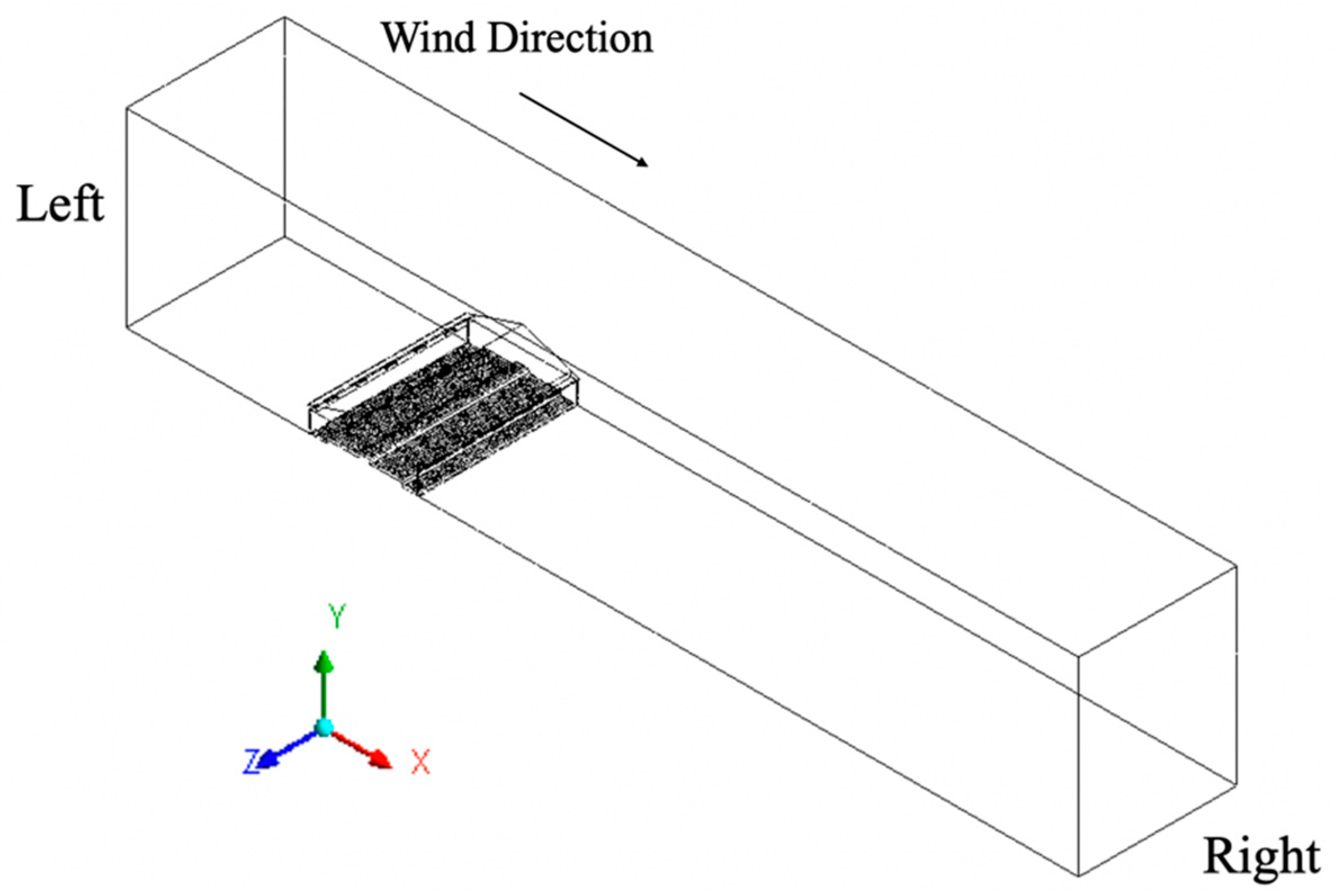

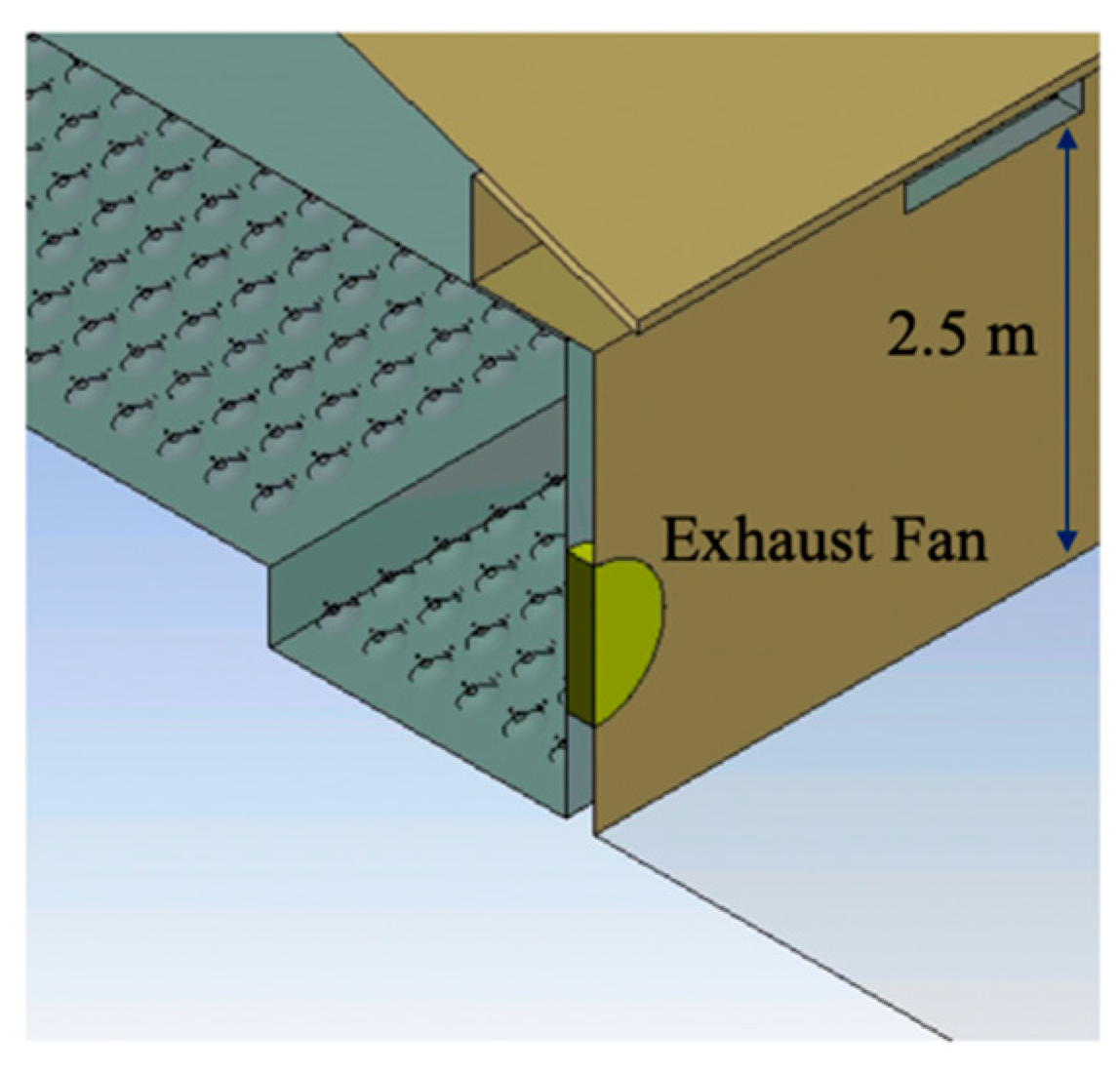
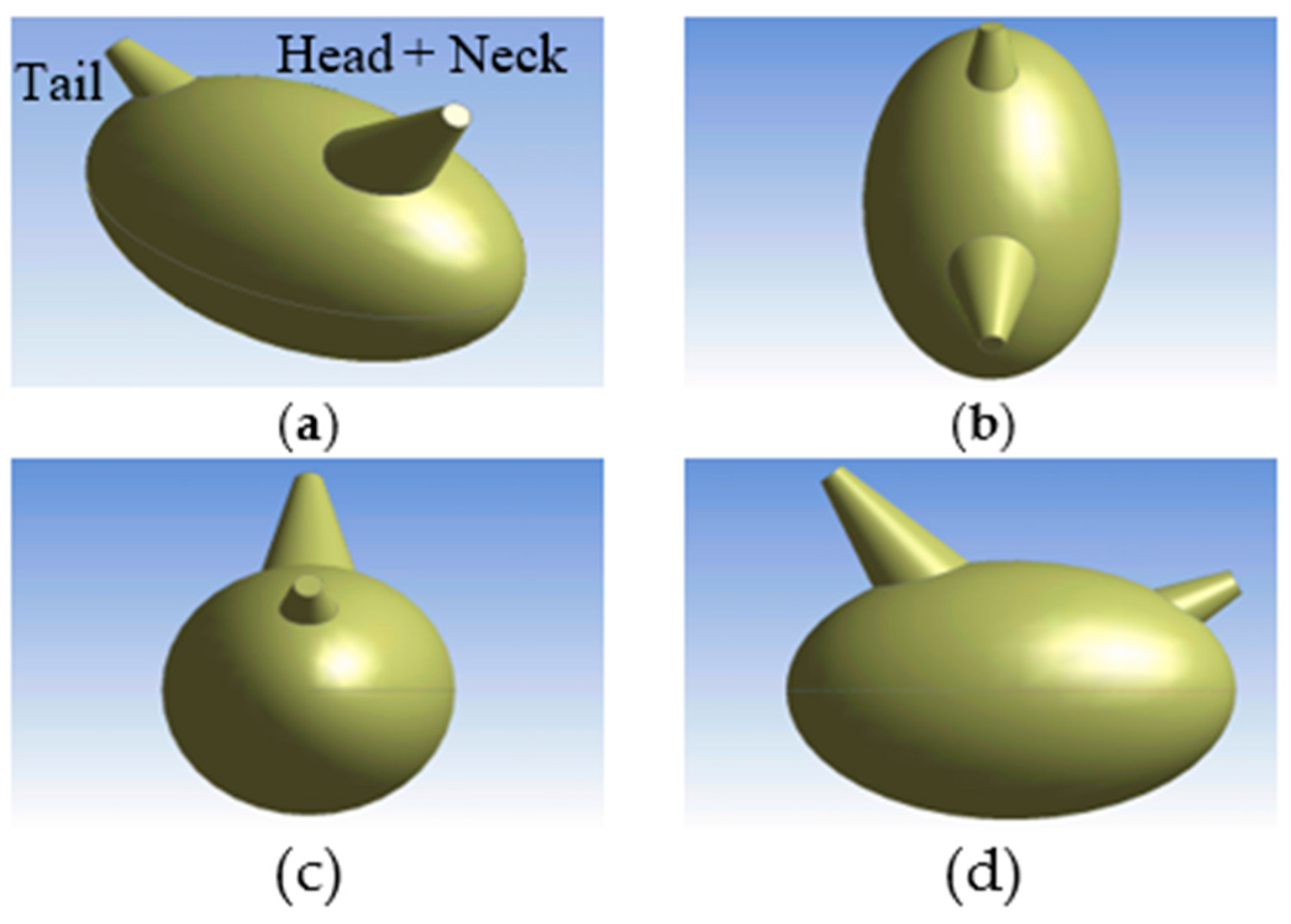
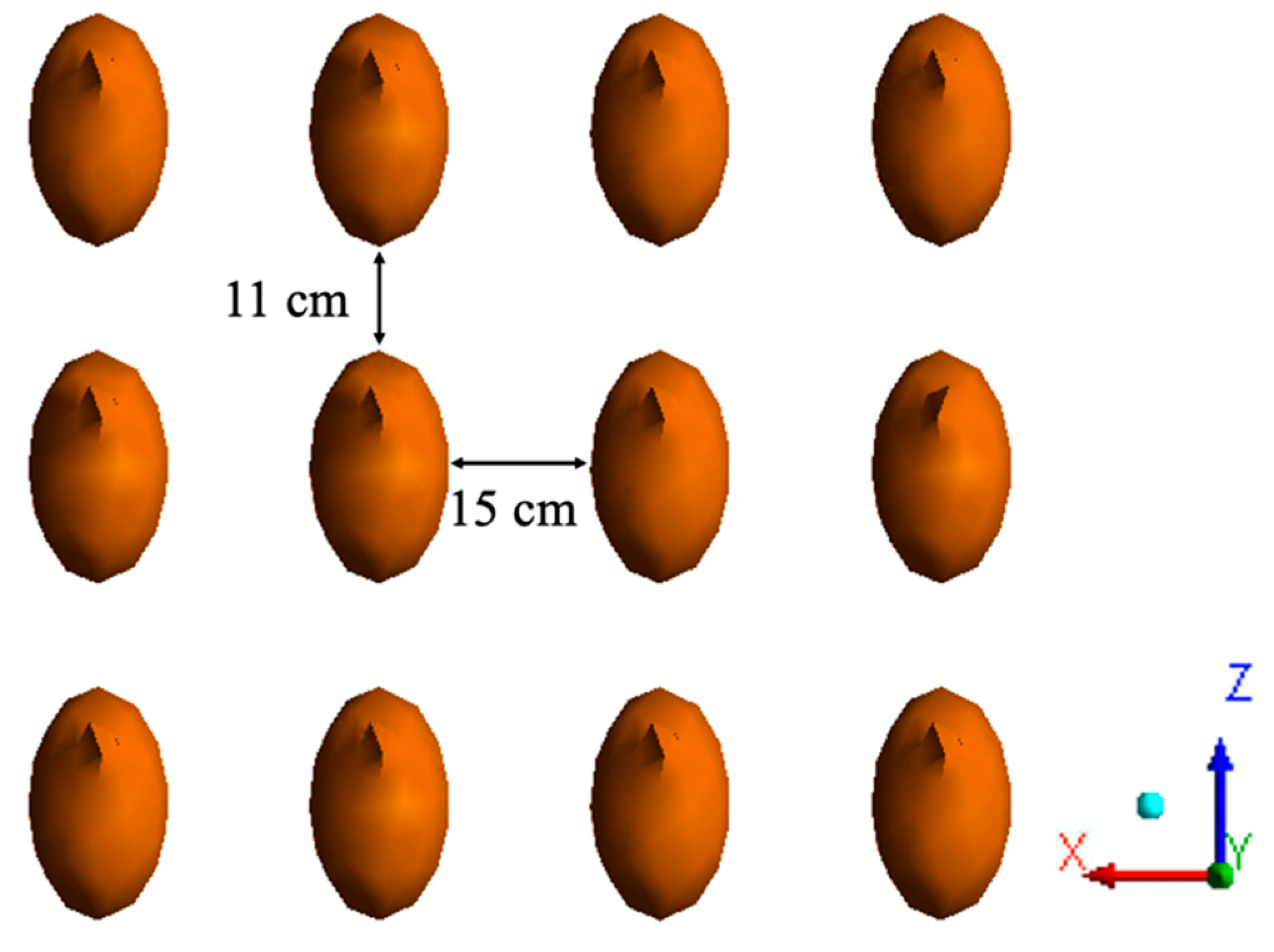
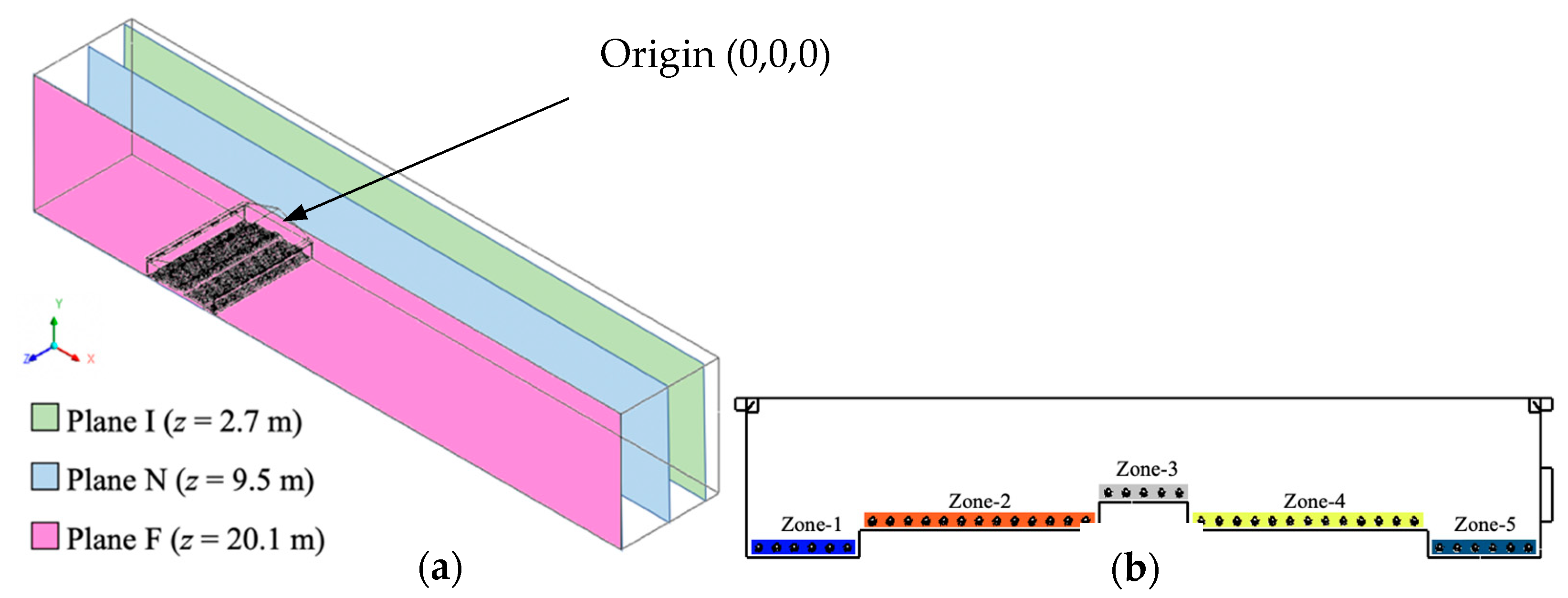
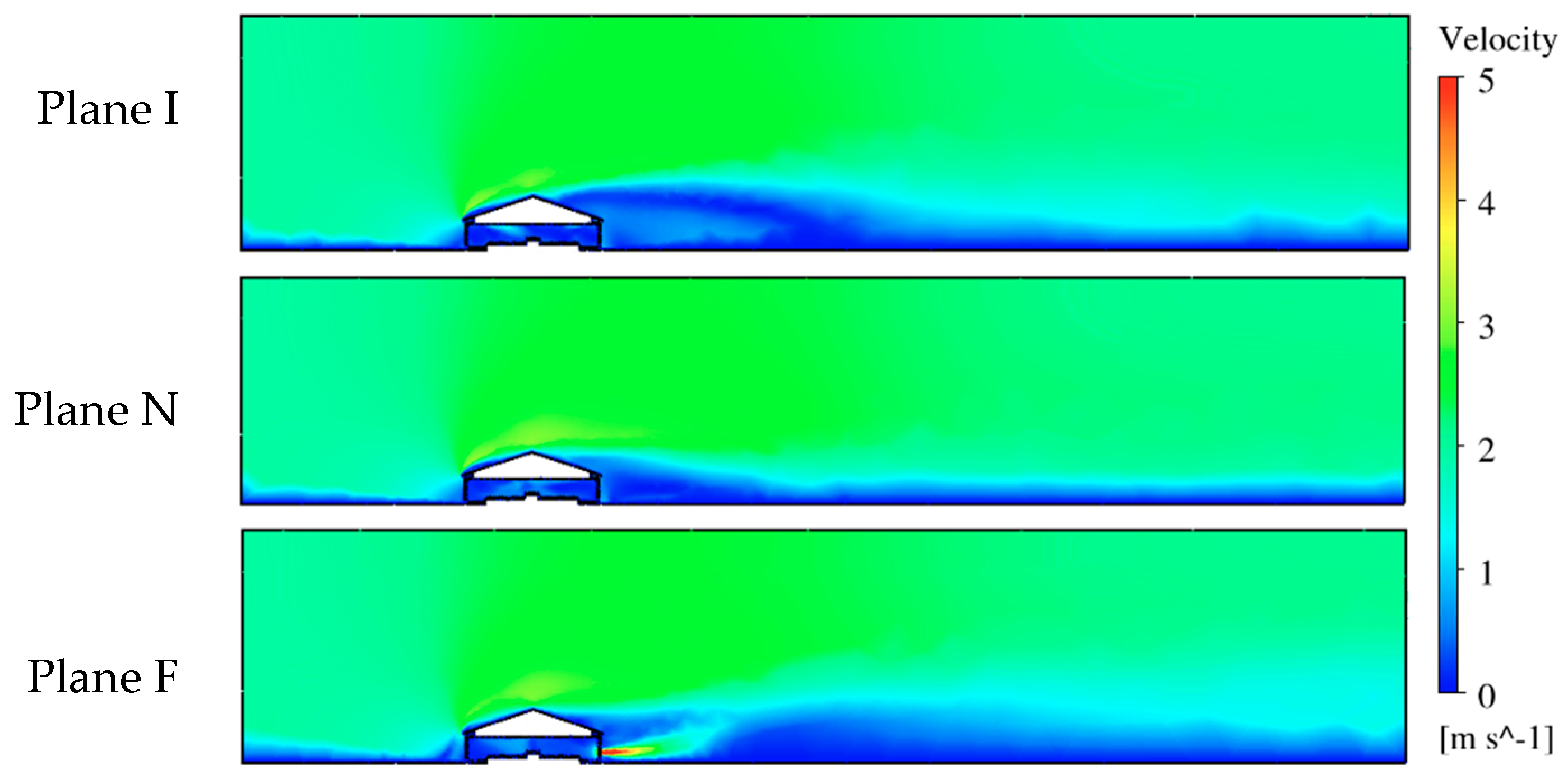
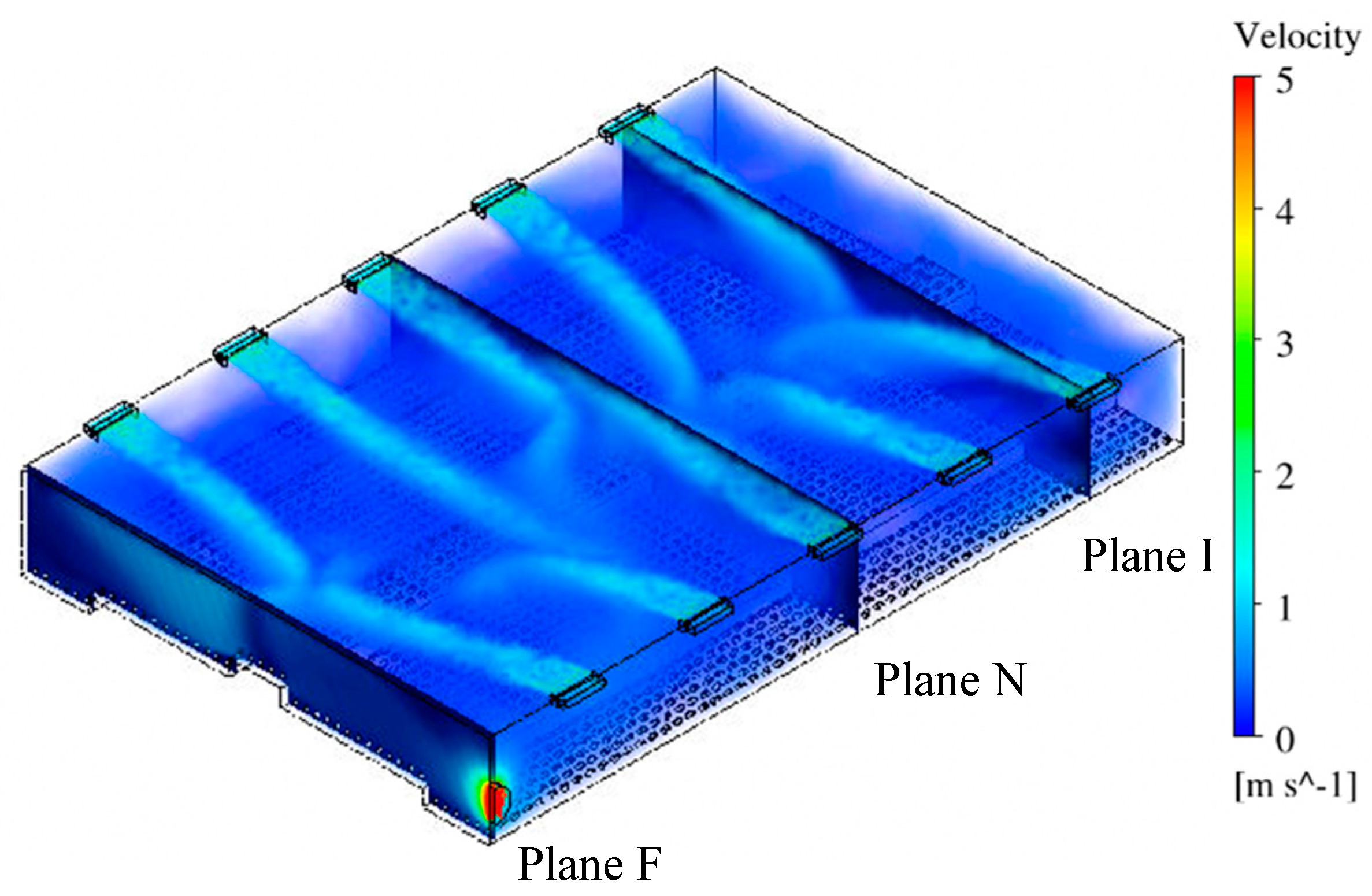
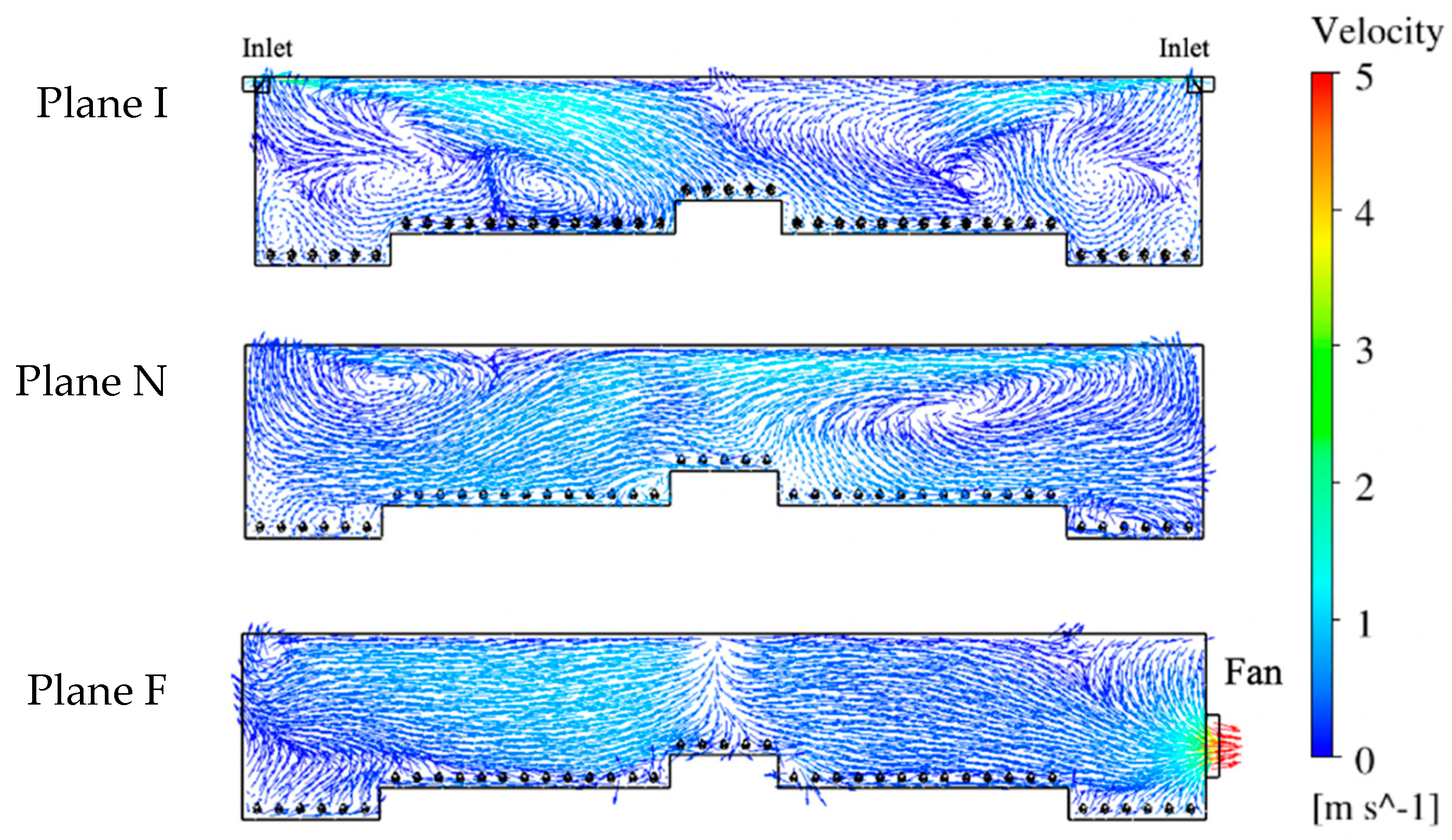
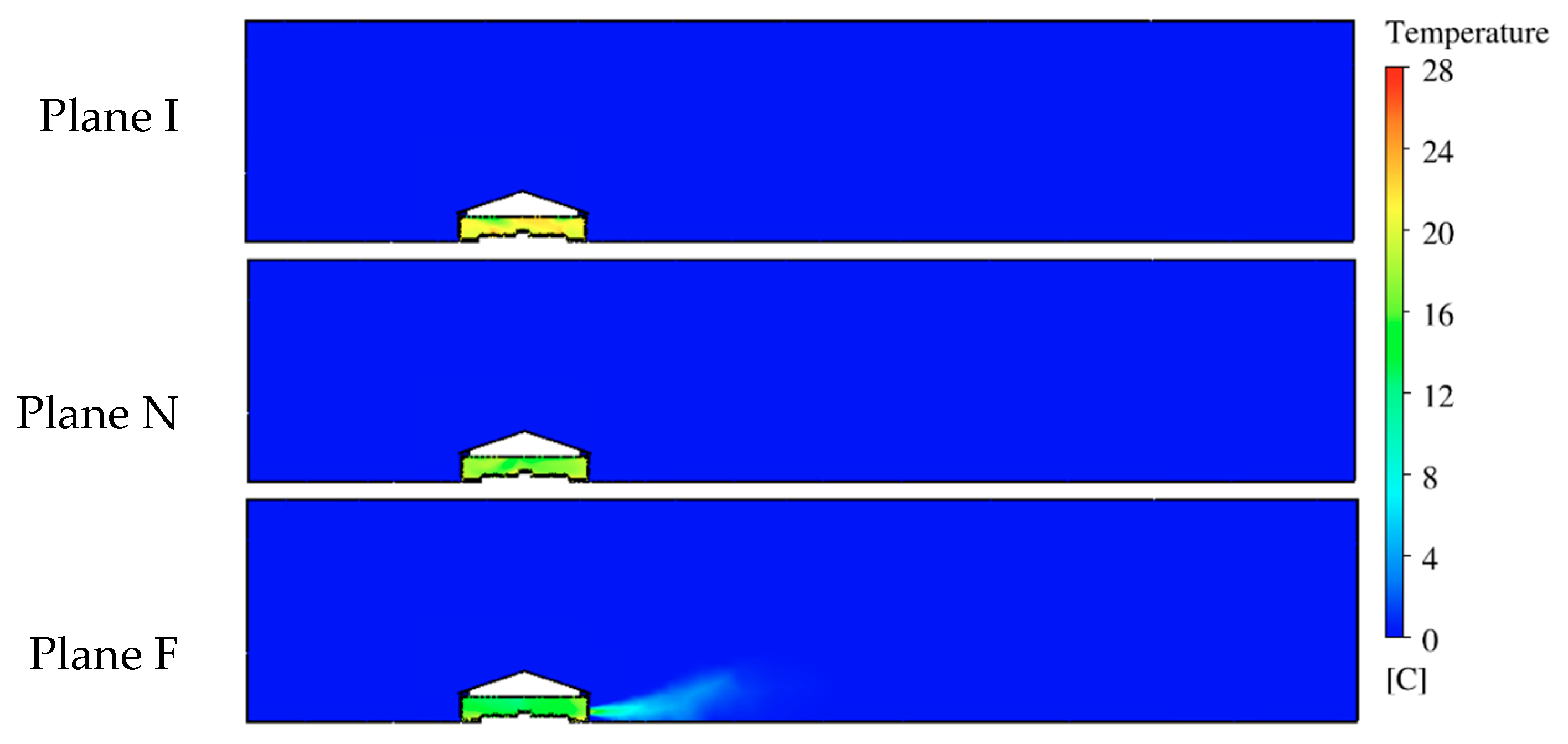
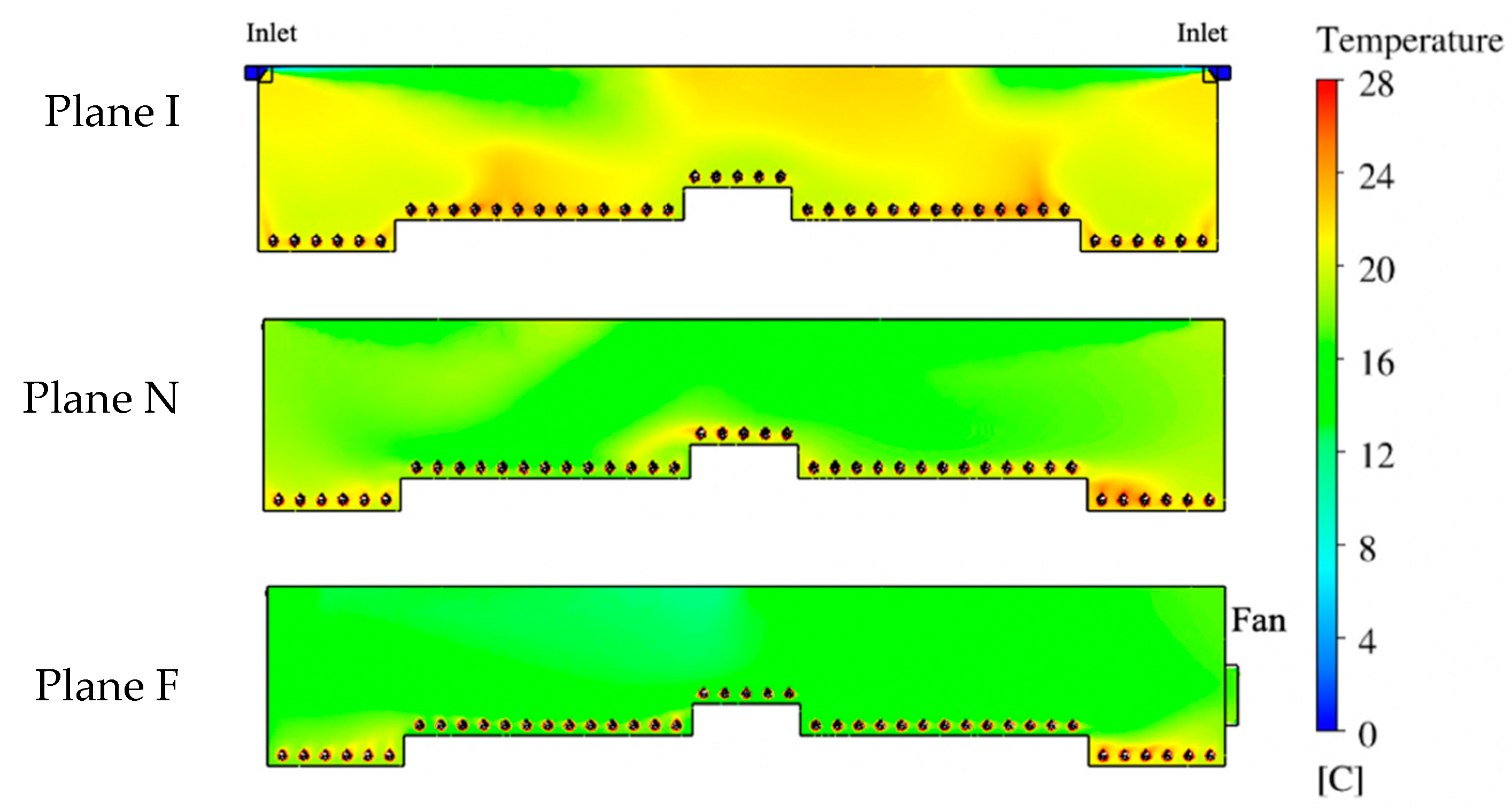
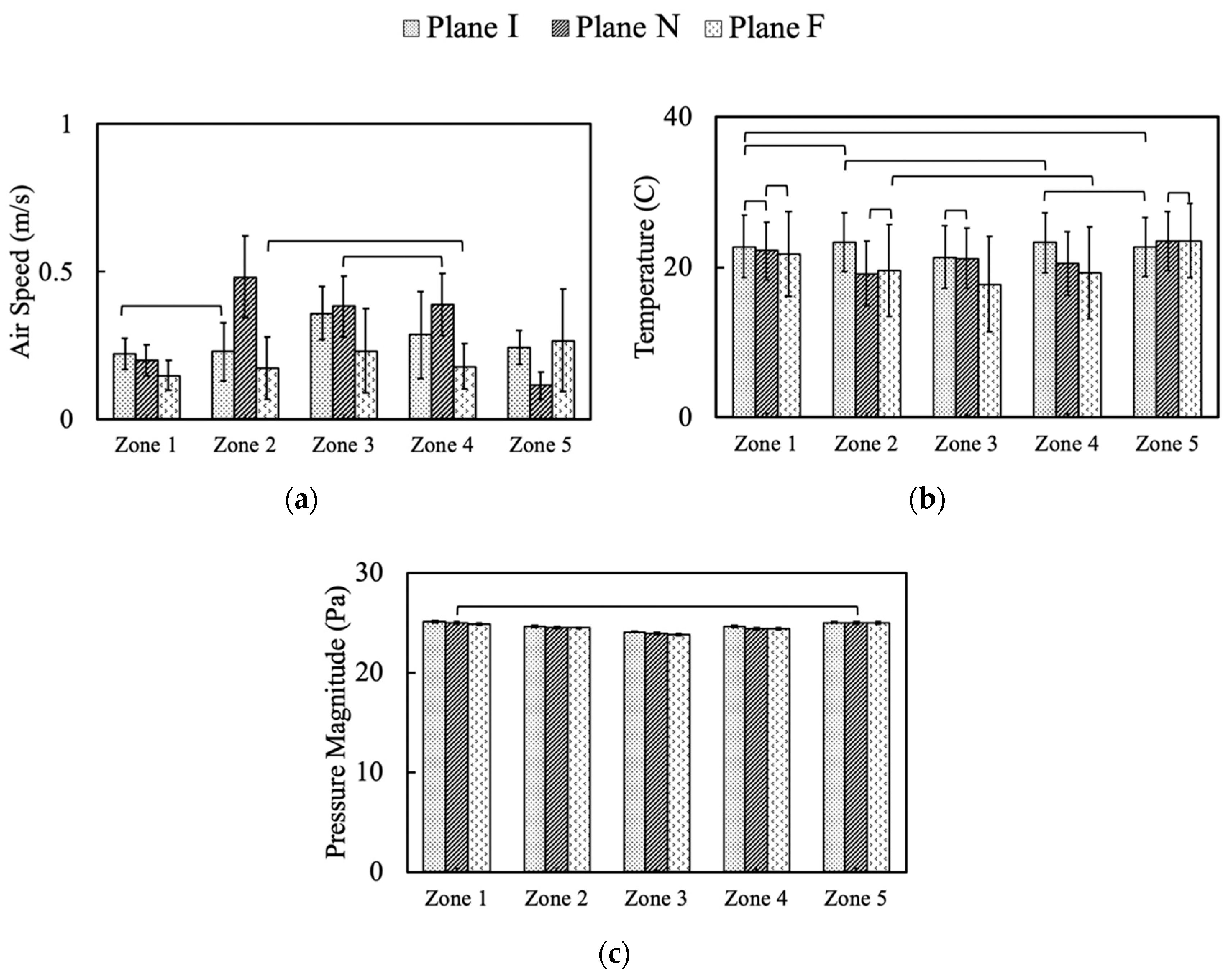
| Parameter | Factor | df | Pr (>F) |
|---|---|---|---|
| Air speed | Plane | 2 | <2.2 × 10−16 |
| Zone | 4 | <2.2 × 10−16 | |
| Plane × Zone | 8 | <2.2 × 10−16 | |
| Residuals | 25,856 | ||
| Temperature | Plane | 2 | <2.2 × 10−16 |
| Zone | 4 | <2.2 × 10−16 | |
| Plane × Zone | 8 | <2.2 × 10−16 | |
| Residuals | 25,856 | ||
| Pressure | Plane | 2 | <2.2 × 10−16 |
| Zone | 4 | <2.2 × 10−16 | |
| Plane x Zone | 8 | <2.2 × 10−16 | |
| Residuals | 25,856 |
© 2020 by the authors. Licensee MDPI, Basel, Switzerland. This article is an open access article distributed under the terms and conditions of the Creative Commons Attribution (CC BY) license (http://creativecommons.org/licenses/by/4.0/).
Share and Cite
Chen, L.; Fabian-Wheeler, E.E.; Cimbala, J.M.; Hofstetter, D.; Patterson, P. Computational Fluid Dynamics Modeling of Ventilation and Hen Environment in Cage-Free Egg Facility. Animals 2020, 10, 1067. https://doi.org/10.3390/ani10061067
Chen L, Fabian-Wheeler EE, Cimbala JM, Hofstetter D, Patterson P. Computational Fluid Dynamics Modeling of Ventilation and Hen Environment in Cage-Free Egg Facility. Animals. 2020; 10(6):1067. https://doi.org/10.3390/ani10061067
Chicago/Turabian StyleChen, Long, Eileen E. Fabian-Wheeler, John M. Cimbala, Daniel Hofstetter, and Paul Patterson. 2020. "Computational Fluid Dynamics Modeling of Ventilation and Hen Environment in Cage-Free Egg Facility" Animals 10, no. 6: 1067. https://doi.org/10.3390/ani10061067
APA StyleChen, L., Fabian-Wheeler, E. E., Cimbala, J. M., Hofstetter, D., & Patterson, P. (2020). Computational Fluid Dynamics Modeling of Ventilation and Hen Environment in Cage-Free Egg Facility. Animals, 10(6), 1067. https://doi.org/10.3390/ani10061067







